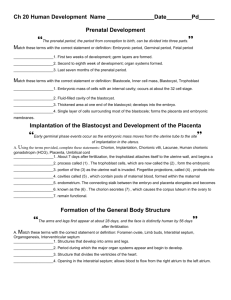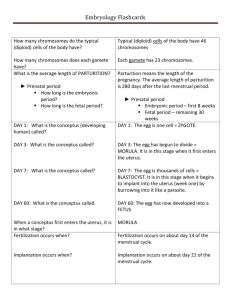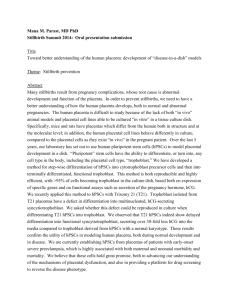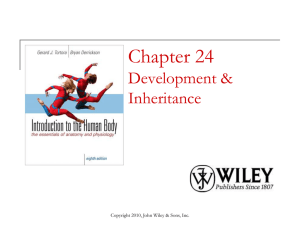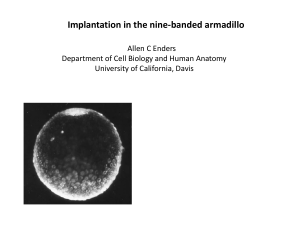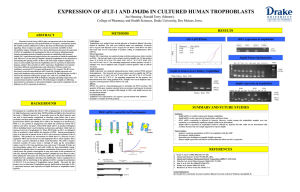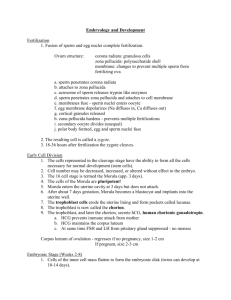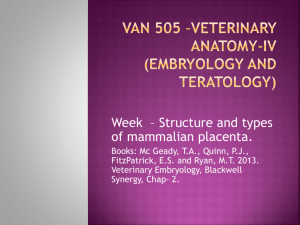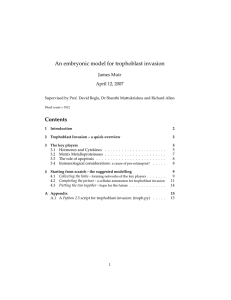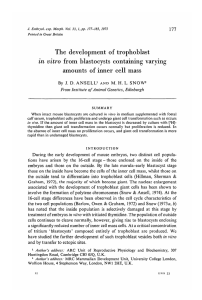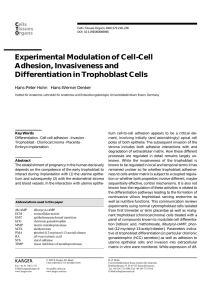Harvard-MIT Division of Health Sciences and Technology HST.071: Human Reproductive Biology
advertisement
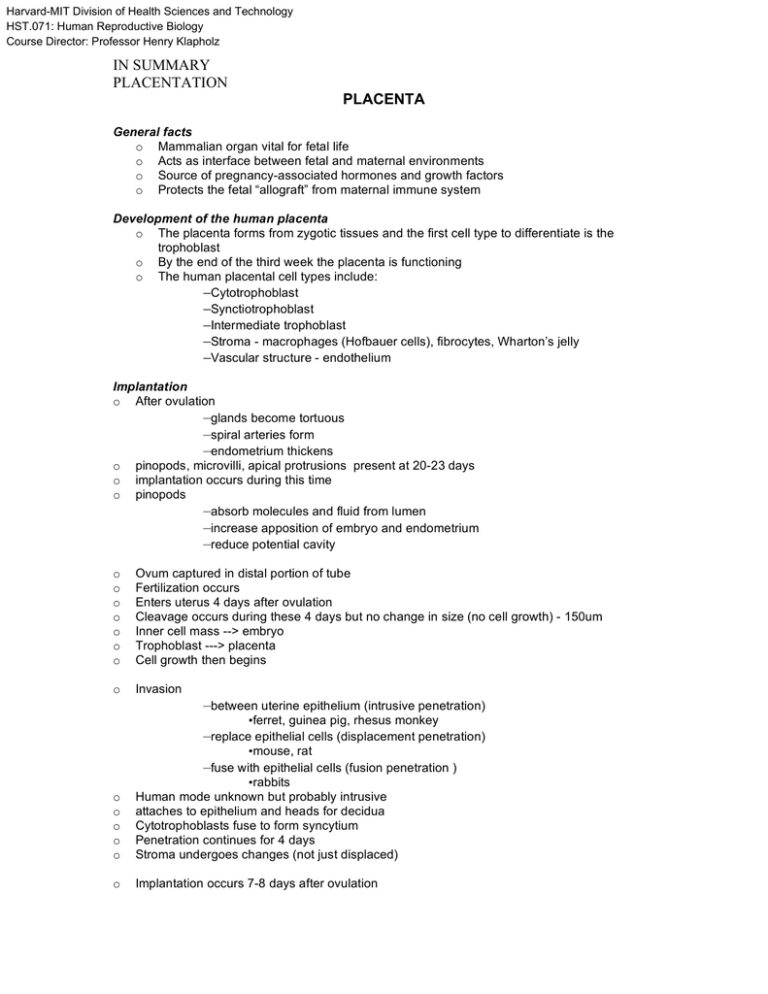
Harvard-MIT Division of Health Sciences and Technology HST.071: Human Reproductive Biology Course Director: Professor Henry Klapholz IN SUMMARY PLACENTATION PLACENTA General facts o Mammalian organ vital for fetal life o Acts as interface between fetal and maternal environments o Source of pregnancy-associated hormones and growth factors o Protects the fetal “allograft” from maternal immune system Development of the human placenta o The placenta forms from zygotic tissues and the first cell type to differentiate is the trophoblast o By the end of the third week the placenta is functioning o The human placental cell types include: –Cytotrophoblast –Synctiotrophoblast –Intermediate trophoblast –Stroma - macrophages (Hofbauer cells), fibrocytes, Wharton’s jelly –Vascular structure - endothelium Implantation o After ovulation –glands become tortuous –spiral arteries form –endometrium thickens o pinopods, microvilli, apical protrusions present at 20-23 days o implantation occurs during this time o pinopods –absorb molecules and fluid from lumen –increase apposition of embryo and endometrium –reduce potential cavity o o o o o o o Ovum captured in distal portion of tube Fertilization occurs Enters uterus 4 days after ovulation Cleavage occurs during these 4 days but no change in size (no cell growth) - 150um Inner cell mass --> embryo Trophoblast ---> placenta Cell growth then begins o Invasion –between uterine epithelium (intrusive penetration) •ferret, guinea pig, rhesus monkey –replace epithelial cells (displacement penetration) •mouse, rat –fuse with epithelial cells (fusion penetration ) o o o o o •rabbits Human mode unknown but probably intrusive attaches to epithelium and heads for decidua Cytotrophoblasts fuse to form syncytium Penetration continues for 4 days Stroma undergoes changes (not just displaced) o Implantation occurs 7-8 days after ovulation IN SUMMARY PLACENTATION o Embryo “targets” hypoepithelial vessels on surface of endometrium o Surface is made receptive for the embryo o Immediate –human o Delayed –facultative (rat, red kangaroo only during stress) –facultative (Alaska fur seal, mink, bear always) –free floating morula/blastocyst with min. met. act. –Light cycle control duration of delay Immature Chorionic Villi Trophoblast cell types o Cytotrophoblast –Stem cell –Mononuclear/euploid –epithelial o Intermediate trophoblast –Invasive/implantation site cell –Mono-multinucleate –hPL>hCG –proteases o Syncytiotrophoblast –Terminally differentiated –Polynucleated-polyploid –hCG> hPL –transport o o Murine placental development E3.5 trophectoderm (epithelial cells) differentiates: –Extraembryhonic ectoderm –Extraplacental cone –Trophoblast giant cells Trophectoderm differentiation o Control over the initial cell fate decision is unclear o After blastocoel forms, signalling between the ICM and the trophectoderm are critical –Fgf4/Fgfr2 IN SUMMARY PLACENTATION Early trophectoderm differentiation •Trophectoderm spatially most distant from ICM become TGC •ICM expresses Fgf4, trophectoderm expressed Fgfr2 •Fgf4 ko embryos are lethal YET Fgf4 -/- stem cells are viable •Oct4 ko lack ICM but make trophectoderm if Fgf4 given •Fgfr dominant negative constructs block trophoblast proliferation •Trophoblast “stem cells” require Fgf4, withdrawn will differentiate to TGC Branching •As the trophoblast grows it branches and increases its surface area •Molecules involved in this process are same as involved in branching morphogenesis in other organs (e.g. lung, kidney) •Initiation of branching - Gcm1 •Branching morphogenesis - Fgf and others downstream/ signal transduction: Grb2, Gab1, Sos1 Mek1 •Wnt canonical pathway via Tcf1 and Lef1 Vasculogenesis •Coordination of vascular pattern with villous pattern varies amongst species –Murine the events are simultaneous –In human, the villi form first then vessels “come in” •Eptihelial-mesenchymal interactions are key •Trophoblast factor - Esx1 •Hypoxia inducible factors important –Hif1b1 –Vegf –Epas Immunobiology of pregnancy •Mother’s immune system has to protect the mother and fetus against pathogens and prevent the rejection of the semi-allergeneic feto-placental unit •Potential for repeated pregnancies with same paternity potentially triggering immune memory Innate vs Adaptive Immunity •Fetal alloantigens are recognized by maternal adaptive immune system •Innate immune response during implantation involves complement activation and neutrophil infiltration Controlled complement activation •Complement regulatory proteins prevent overdrive of complement activation in successful pregnancies •Complement mediated cell lysis is regulated by factors: –DAF/CD55 –MCP/CD46 –Crry IN SUMMARY PLACENTATION Complement •C3 deposition at maternal-fetal interface results in hemorrhagic necrosis and neutrophil infiltration leading to fetal resorption •Crry -/- abort •Crry -/- crossed with C3 -/- produce viable fetuses •C3 deficient mothers have no fetal injury even when injected with aPL which results in antibody deposition in the decidua T-Cell dependent inflammation inhibited by IDO •Tryptophan is needed for cell proliferation and is lower in pregnant than in non-pregnant women •IDO degrades tryptophan •IDO is expressed by syncytiotrophoblast, macrophages, and antigen presenting cells •Macrophages suppress T cell activity due to degradation of tryptophan by IDO •Treatment with an IDO inhibitor leads to inflammation, complement deposition and hemorrhagic necrosis at fetomaternal interface Role of HLA-G •Nonclassical HLA class I molecule expressed in trophoblasts, amnion, and thymic epithelial cells •7 distinct protein isoforms each encoded by a specific alternatively spliced transcript •4 are membrane bound and 3 are soluble •Inhibit NK cell mediated cytolysis and Ag specific CD8+ T cell mediated cytolysis HLA-G and Implantation •Normally highly expressed by invading trophoblast •Greatly reduced in trophoblasts from spontaneous abortions and in patients with preeclampsia •Zygotic expression of soluble HLA-G is required for blastocyst attachment Adhesion molecules •Integrins –cell to cell adhesion receptors –cell-to-cell matrix reactions –21 different types –anchor cells to specific locations –transmit information to cells •Immunologic homing •Metastatic spread •Healing IN SUMMARY PLACENTATION –Heterodimers composed of α and β subunits –Ligand specificity a function of αβ heterodimer –May bind to several ligands –Ligand may bind to several heterodimers •constituitivly expressed •phasic and hormonally regulated –infertility ? Related to reduced endometrial expression of β3 –defect in embryonic expression of β1 causes involution of inner cell mass but preserves trophoblast –polarity •Distribution of the integrins either promotes or retards attachment –Switching •Early trophoblast exhibits α5β1 but later changes to α1β 1 •May regulate invasiveness FUNDAMENTAL QUESTIONS 1. 2. 3. 4. 5. 6. 7. 8. What cell types are seen in the human placenta? How does a human placenta differ from that of a dog? rabbit? Describe the process of implantation? How is invasion accomplished? What types of trophoblast are seen? Why is the placenta not rejected? Describe the branching process of the placenta? What is an integrin? How do integrins act in placental development?
